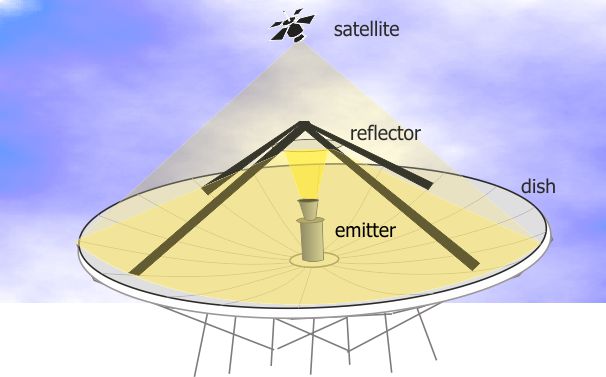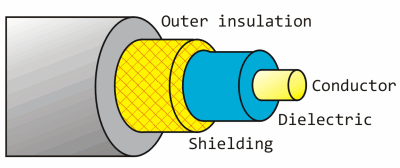Freesat reception - all about dishes
 Brian Butterworth published on UK Free TV
Brian Butterworth published on UK Free TV Satellite reception has both advantages and disadvantages compare with terrestrial (aerial) reception.
By using much higher frequencies (gigahertz, compared to terrestrial televisions megahertz) more transmission channels called transponders (the satellite equivalent of multiplexes) can be provided. For example, there are only six Freeview multiplexes, but Sky or Freesat users can access two hundred satellite transponders.
Aside from exceptional weather conditions (very heavy rain for example) digital satellite provides stable pictures and audio. Where Freeview transmitters are no more than 732 metres above sea level, the geostationary satellites used for television are 35,800,000 metres above the equator so reception is possible even where buildings, trees and hills make terrestrial reception impossible.

The downside of the transmitters being 22,300 miles up in the air is that the signals are very, very weak - so standard TV aerial is of little use. When the signals are sent to the satellites, huge dish transmitters are used to uplink the signal to the satellite. These are tens of metres from side to side, and feature an emitter that generates the signal, which is first bounced of a mirror (called a reflector) and then off the surface of the parabolic dish.

There are many satellites in the sky over the equator. Often these are in clusters over a particular position, for example there are four used for UK television are at 28.2 degrees east. There is another cluster over the 19.2 degrees east positions that are used for German television.
To receive these very weak signals from the satellite, it is necessary to use a dish for reception too. By using a reflective dish, this concentrates the signals onto a small device called a LNB. This is held in front of the dish by a metal arm.

The size of dish for reception is typically much smaller; often 60cm to 100cm in diameter, but the exact size depends upon the transmitting satellite transponder. To keep the transmission power levels down to levels that can be powered by the satellite's solar panels, each beam is focused on a particular area of the Earth's surface. If you are trying to receive the signal at the centre of this zone, a small dish is required. At the outer edges, you may need a 5 metre dish. Maps of these zones are provided by the satellite companies, and are called satellite footprints.
When the dish is installed it must be aligned carefully as the signal is very weak. The installer needs to know the inclination and the azimuth from the ground location to the satellite. If you install yourself you will find that there are markings on the dish that are used to point the dish in the correct position. It is important that the view of the satellite will not be blocked, so must take into account leaves growing on trees and potential building works.
For many people the LNB will have a single cable connected to it, however if you have Sky+ or a multi-room installation the LNB package will actually contain four receivers a quad-LNB. Unlike terrestrial television where you can split the aerial cable to feed more than one Freeview box or television set, with satelite reception you cannot. So, a Sky+ box with two receivers (so you can watch one thing and record another) has two cables connecting the box to the dish.
The cable that connects the dish to the receiver must be satellite grade cable. Whilst this looks superficially like the cable used to connect and aerial to a television, a higher grade cable is required for satellite reception.
Here is an image of a co-axial cable. This sort of cable is used to connect any type of receiving aerial to the reception equipment.

RG6, PF100 and PH100 are all types of coax cable that are suitable for the very weak signals that are received by a satellite dish. (The power is the same as you would receive from a one-bar electric heater on the moon).
The conductor in the centre passes the signals received from the dish to the set-top box. This is made from steel in RG6 cable, and from copper in the RF100 and PH100 types. This makes RG6 less suitable in the UK where rain can damage the cable.
The shielding is responsible for keeping unwanted external interference from damaging the signal. In the cheaper cable this will be a foil wrap, in better specified cables this is a braid (or mesh) of copper wires. The sheild in the RF100 covers 58% of the cable.
The non-conducting layer between the shield and the conductor is called the dielectric. This can be either a solid (RG6), foam (RF100) or air-spaced (PH100) dielectric. This makes the cables progressively more flexible (ie bendy without damage).
8:33 PM
Doug: What model of Sky box are you using?, the label indicating this info on either the rear or underside of the box.
As far as the problem alleged as being down to a weather related issue, this can only happen on a perfectly aligned dish during an extremely heavy thundery type rainstorm, or alternatively if not raining, when really dense rain clouds are passing over head.
A secondary reason linked to the above can be due to water having crept into the "F" connector on the dishes LNB, the result of sometimes only showing up once the weather has cleared up and the connector has been slightly warmed up by the sun.
Although not quite so commonly experienced, but another thing that can cause problems to satellite reception is if the dish is being partially obstructed by nearby vegetation, such as leaves on a branch of a tree etc.
| link to this comment |
11:44 PM
MikeP: Yes, multiswitch distribution systems certainly offer the ultimate in flexibility, although as you will obviously appreciate what you are referring to is a cut down (not so large) version of a professional system as used for the distribution of satellite & terrestrial signals in premises ranging from guest houses to flats located in large apartment blocks, likewise costly to install over that of a quad (or octo) block, that is including the running of the coax feeds to the various locations that the satellite devices are being used in.
| link to this comment |
10:52 PM
jb38
The distribution amplifier I was suggesting is designed for multi-room usage in homes and not just commercial premises. Many people I know use them as part of their home installation as it allows all TV, Satellite and radio signals to be made available in a number of rooms, depending on the model chosen. The advantage is you only need 1 dish, 1 TV aerial and perhaps 1 FM/DAB aerial, so not so unsightly as multiple fitments. The smaller ones from Labgear only cost in the region of £80, but as you say you have to add the cost of cabling. My fsamily have all done it in their homes already (we are all electronics engineers) and I plan to fit such in my new home (only been here 10 days so still unpacking boxes!).
| link to this comment |
12:14 AM
MikeP: I fully appreciate that said about the advantages of using a multiswitch system, likewise do not in any way whatsoever have any issues with what you have said, as all I was really meaning is that the system being referred to "is" allied to the larger scale professional way of doing things, and as such cant really be said as being commonly used in the average domestic household, especially so with Stuarts query being in mind!, quad or octo blocks being the order of the day in situations where a few satellite PVRs are being used.
| link to this comment |
8:56 PM
I live in Spain eighty miles south of Barcelona. Is it possible to get UK freeview using a satellite dish?
| link to this comment |
Dorothy Morgan: Can you see Can I stop paying Sky and use my satellite receiver to get Freeview ? please?
| link to this comment |
7:35 PM
Ron
By 'TV reception' do you mean Freeview? Or do you mean FreeSat? Or do you mean Sky TV? They are all different and should not be confused with each other.
Reception of the terrestrial services provided by FreeView requires a suitable aerial correctly mounted on the house and aimed at a ground-based transmitter (there are many and a Post Code would help us advise which may be the best for your location). So you cannot use a dish to receive those services. Obviously you need a suitably equipped TV set or a 'set top box' designed for Freeview reception.
Reception of FreeSat and/or Sky TV is only possible by using a dish suitably aimed at the required satellites and feeding the signals into a suitable receiver, designed either for FreeSat or Sky reception. Note that Sky normally requires a subscription if you want more than just the basic PSB services. Any TV set will be able to display the programmes received this way, but some modern TVs have an in-built tuner for the satellite signals, some being capable of HD as well as SD services. Sky reception is always by using a 'set top box' which they supply when you take out a subscription with them. Note also that an aerial will not enable reception of satellite provided services.
Hope that helps?
| link to this comment |
6:33 PM
I have used Passion+ satboxes for some time. At some time in the past, my reception of BBC and CH4 HD channels has been less than good (ITV HD is ok). The picture is "jerky"; i.e. it tends to freeze for short periods, although the sound is reasonable.
Do you know why there could be a difference between ITV and the other HD channels?
| link to this comment |
9:26 PM
Thank you Mike. As I quoted Passion+ satboxes, I thought you would have known that a I was referring to satellite channels. Why is there a difference between the 'reception' of ITV HD (good) and BBC and CH4 ("jerky")?
| link to this comment |